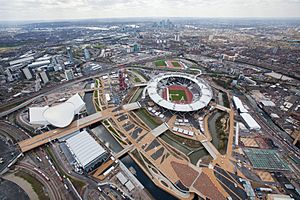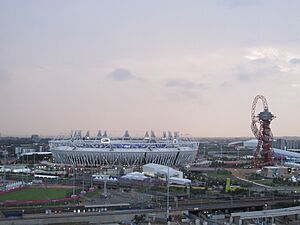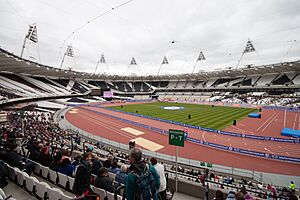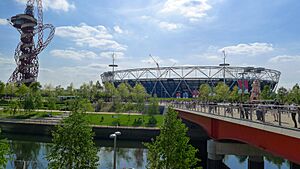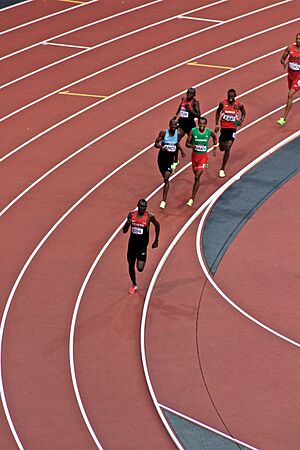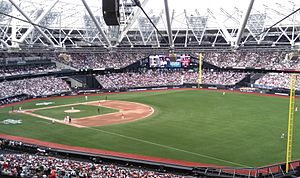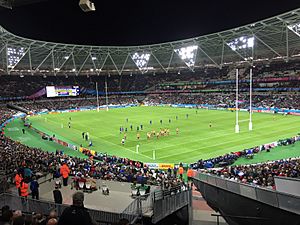London Stadium facts for kids
 |
|
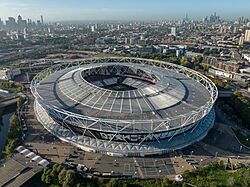
View of the stadium in October 2022
|
|
| Former names |
|
|---|---|
| Address | Marshgate Lane |
| Location | Queen Elizabeth Olympic Park Stratford, London, England E20 2ST |
| Public transit | |
| Owner | E20Stadium LLP GLA Holdings LTD |
| Operator | E20Stadium LLP / Stadium 185 Ltd. |
| Capacity |
|
| Field size | 105 by 68 metres (114.8 yd × 74.4 yd) |
| Surface | Grass (Desso GrassMaster) Track (Mondotrack/WS, 9 Lanes) |
| Construction | |
| Broke ground | 22 May 2008 |
| Built | 22 May 2008 – 29 March 2011 |
| Opened | 5 May 2012 |
| Renovated | 2013–2016 |
| Construction cost | £486 million (£486 million in 2021 pounds ) £274 million (2013–16 renovations) |
| Architect | Populous (formerly HOK Sport), led by Philip Johnson |
| Project manager | Savills |
| Structural engineer | Buro Happold |
| Services engineer | M-E Engineers |
| General contractor | Balfour Beatty |
| Main contractors | Sir Robert McAlpine |
| Tenants | |
| UK Athletics (2015–present) West Ham United (2016–present) |
|
The London Stadium is a large outdoor stadium in Stratford, East London. It is part of the Queen Elizabeth Olympic Park. This stadium was first built for the 2012 Summer Olympics and 2012 Summer Paralympics. It hosted the athletics events and the opening and closing ceremonies for both Games.
After the Olympics, the stadium was changed to be used for many different things. Now, it is mainly the home of Premier League football club West Ham United. They started playing there in 2016. UK Athletics also uses the stadium. They host a big athletics event called the London Grand Prix every year.
The stadium was built between 2008 and 2011. It could hold 80,000 people for the Olympic Games. Later, it was rebuilt to have 66,000 seats. For football matches, the capacity is usually 62,500. The stadium is owned by E20 Stadium LLP and GLA Holdings Ltd. It is managed by E20 Stadium LLP and Stadium 185 Ltd.
Who Runs the London Stadium?
Stadium Management Over Time
During the 2012 Olympic and Paralympic Games, the stadium was run by the London Organising Committee (LOCOG). After the Games, the London Legacy Development Corporation (LLDC) took over the entire Olympic Park. In 2012, the LLDC and Newham Council created a company called E20 Stadium LLP to manage the stadium long-term.
In 2015, a company called Vinci Stadium was chosen to manage the stadium for 25 years. Vinci then set up its own company, London Stadium 185 (LS185), to do this. The number 185 represented the medals won by British athletes in the London Games. In 2019, the LLDC bought LS185 from Vinci.
In 2025, the LLDC handed over its share in E20 Stadium LLP and LS185 to GLA Holdings Ltd. This company is part of the Greater London Authority (GLA). The E20 Stadium company was then renamed London Stadium LLP. This change happened because the GLA helps fund the stadium, and it allows the LLDC to focus on other projects in the park.
How the Stadium Came to Be
London's Olympic Dream
Great Britain tried to host the Summer Olympics several times before 2012. The International Olympic Committee (IOC) suggested that London should bid if Britain was serious. In 1997, a study looked into hosting the Games. Two main ideas came up. One was to use Wembley Stadium in West London. The other was to build a new area in East London, in the Lower Lea Valley.
At first, there were plans for a new athletics stadium at Picketts Lock. However, these plans were cancelled because they were too expensive. It was then realized that Stratford in East London would be a better place for an Olympic Park.
When Beijing won the 2008 Olympics, it opened the door for London to bid for the 2012 Games. London's Mayor, Ken Livingstone, supported the bid. He wanted to use the Games to help improve East London. In 2005, the IOC chose London to host the 2012 Olympic Games.
Where is the Stadium Located?
The stadium is built on land that used to be industrial. It is surrounded by parts of the Bow Back Rivers, like the River Lea and the City Mill River. This area is like an "island" surrounded by water. To build the stadium, some smaller rivers had to be filled in.
The stadium is in the southern part of the Queen Elizabeth Olympic Park. This is in the Stratford area of London. It is about 6 miles (10 km) east of central London.
Building the London Stadium
Designing the Olympic Stadium
When London bid for the Games, the stadium was shown with a roof that looked like "muscles supporting the body." The government wanted a stadium mainly for athletics that could be taken apart after the Games. The lower part would stay as a permanent athletics facility.
In 2006, Sir Robert McAlpine and Populous were chosen to design and build the stadium. The final design was revealed in November 2007.
How it was Built
Building the stadium started early, in May 2008. The ground was dug out, and the area was cleared. The stadium was finished in March 2011, on time and under budget. The athletics track was laid in October 2011.
The stadium has two main parts:
- The bottom part has 25,000 seats. It is a sunken bowl made of special concrete that uses less carbon. Its foundations go up to 20 meters deep.
- The top part has 55,000 seats. It is made of lightweight steel and concrete.
The stadium used much less steel than the Beijing National Stadium from the 2008 Olympics. It is 75% lighter. Many building materials were brought by trains and barges to reduce pollution.
A special "wrap" was added to the outside of the stadium in 2011. This wrap helped reduce strong winds inside. It was made of polyester and polyethylene and covered a huge area. The wrap had fabric panels twisted at angles, allowing people to enter the stadium.
The roof covered about two-thirds of the seats. It had 14 lighting towers with 532 floodlights. These lights were first turned on in December 2010.
Inside the Stadium
The stadium had a nine-lane athletics track made by an Italian company called Mondo. The grass for the field was grown in Scunthorpe. The 80,000 seats had a black-and-white design that matched the London 2012 branding.
During the Games, the stadium's seats had a special lighting system. 70,500 small "paddles" with nine LED lights each were placed between the seats. These could display videos and patterns around the stadium. This system set a Guinness World Record for the largest landscape video display.
How People Felt About the Design
People had mixed feelings about the stadium's design. Some called it "magnificent," while others thought it was "underwhelming." It was praised for being "sustainable" because it could be taken apart. However, some critics felt it wasn't as grand as the Beijing Olympic Stadium.
The stadium was nominated for the 2012 Stirling Prize for architecture. It lost to the Sainsbury Laboratory at the University of Cambridge.
After the Olympic Games
Finding a New Tenant
The plan for the stadium after the Olympics was to turn it into a smaller athletics stadium with 25,000 to 30,000 seats. It would also have a sports training center. It was important for London to have a top-class athletics stadium.
At first, football clubs like West Ham United and Tottenham Hotspur were interested in moving in. However, the Mayor of London, Ken Livingstone, said it would be scaled down for athletics only. Later, the idea of a football club using it, while keeping the athletics track, was considered.
In 2010, a process began to find a new tenant for the stadium. Many groups showed interest, including cricket clubs, rugby clubs, and even Major League Baseball. Two bids were chosen for final talks: one from Tottenham Hotspur and another from West Ham United with Newham Council.
West Ham planned to change the stadium to hold 66,000 people. They wanted to host football, athletics, cricket, and other events. Tottenham wanted to knock down the stadium and rebuild it just for football.
West Ham Becomes the Main Tenant
In February 2011, West Ham United and Newham Council were chosen as the preferred bidders. This decision was approved by the British Government and Mayor Boris Johnson.
However, there were legal challenges from other clubs like Leyton Orient and Tottenham Hotspur. They were concerned about the fairness of the process. To avoid long delays, the original deal was cancelled in October 2011. It was decided that the stadium would stay publicly owned and be leased to a main tenant.
A new process started in December 2011. It was made clear that an athletics track must remain in the stadium, which would be scaled to 60,000 seats. In December 2012, West Ham was again chosen as the preferred bidder.
On 22 March 2013, West Ham United signed a 99-year lease. The stadium became their home ground from the 2016–17 season. UK Athletics also got a 50-year deal to use the stadium for part of each summer.
Changes After the Olympics
Making the Stadium Ready for New Uses
The stadium was planned to reopen in 2015 after major changes. The E20 LLP company managed this work. The goal was to make it a top-level stadium for both football and athletics. West Ham, Newham Council, the LLDC, and the British Government all helped pay for the changes.
The stadium got a new, larger transparent roof. This roof is twice the size of the original and covers every seat. It also helps improve the sound inside the stadium. New corporate areas, toilets, and food stalls were added. The seating was made retractable, meaning it can move closer to the pitch for football.
Work started in August 2013. 25,000 seats and the grass were removed. The athletics track was covered to protect it. New floodlights were installed in 2015. These lights are 18 meters tall and weigh 45 tons each. They hang from the roof.
In 2024, plans were approved to install solar panels on the stadium's roof. These panels will generate enough energy to power all major events at the stadium. This is a big step for the stadium to be more environmentally friendly.
The old athletics track surface was replaced in May 2016 with a new one. The grass playing field was also replaced with a special hybrid grass pitch called Desso GrassMaster. This pitch is approved for Premier League matches and has under-soil heating.
New Look Inside
The black-and-white seats from the Olympics were changed to white, blue, and claret (a dark red). These are West Ham's team colors. The new design includes West Ham's name on one stand and crossed hammers, which are the club's symbol.
To make the stadium feel more like home, West Ham added a claret-colored carpet around the pitch in 2019. They also placed a statue outside the stadium called "West Ham United's European Champions." This statue shows famous players Bobby Moore, Geoff Hurst, and Martin Peters celebrating their 1965 European Cup Winners' Cup win.
In 2020, West Ham announced plans to move some lower-tier seats closer to the pitch. In 2022, the capacity for football matches was increased to 62,500. The total seating capacity is now 68,013.
Community Athletics Track
A new permanent athletics track was built north of the stadium. This track has six lanes (eight on the straight parts). It was funded by a grant from the London Marathon Trust and opened in October 2017.
This track helps the London Stadium meet international athletics rules. It is home to the Newham and Essex Beagles Athletic Club. It is also used by Altis FC and the Bobby Moore Academy.
Stadium Challenges
When the stadium first opened for new events, some spectators had concerns. There were comments about long queues, limited Wi-Fi, and some seats having poor views. Football experts also noted that fans were quite far from the pitch.
At the start of the 2016–17 football season, there were some crowd issues during West Ham matches. These led to increased security measures. More stewards were put in place, and barriers were strengthened to keep opposing fans apart.
In 2018, there were protests during a West Ham match. The club was later fined for these disturbances. Investigations showed that the stadium operators had made some mistakes in managing security. Since then, further steps have been taken to improve safety and fan experience.
Exciting Events at the Stadium
London 2012 Olympic and Paralympic Games
The London Stadium hosted its first public event in March 2012, a 5-mile run. In May 2012, it held an athletics event and the British Universities Athletics Championships.
The stadium was the main venue for the opening and closing ceremonies of the 2012 Olympic Games. During the athletics events, many new world records were set. These included David Rudisha in the 800 meters and the Jamaican men's 4 × 100 meters relay team. The United States women's 4 × 100 meters team also set a new world record.
The stadium also hosted the opening and closing ceremonies of the 2012 Paralympic Games. Many world records were broken by Paralympic athletes on the track and in field events.
Athletics Events
London successfully bid to host the 2017 World Championships in Athletics. The World Para Athletics Championships also took place at the stadium just before the main championships. At these events, Great Britain set a European record in the men's 4x100m relay. Emma Coburn set a championship record in the 3000m steeplechase.
The London Grand Prix, a major athletics event, moved to the stadium in 2013. It is now a regular event there, sometimes called the "Anniversary Games." Many world, Diamond League, European, and Asian records have been set at these meetings. For example, Kendra Harrison broke the women's 100m hurdles world record in 2016.
The stadium also hosted the first Athletics World Cup in 2018, which was won by the United States.
Football Matches
West Ham United moved into the stadium in August 2016. Their first game was a Europa League match, which they won 3–0. The official opening match was a friendly against Juventus. West Ham's first Premier League match at the stadium was against AFC Bournemouth.
The stadium has also hosted other football events. In 2022, it held the National League play-off final. It has also hosted charity football matches like Soccer Aid and the Sidemen Charity Match. In March 2024, the stadium hosted its first international football match between Spain and Colombia.
Baseball Games
The stadium has hosted Major League Baseball (MLB) games. In 2019, the Boston Red Sox and New York Yankees played two games there. These were the first MLB regular season games ever played in Europe. The stadium was changed to look like an American baseball stadium.
The Chicago Cubs and St. Louis Cardinals played games at the stadium in 2023. The deal to host MLB games has been extended for 2024 and 2026.
Motorsport Events
In November 2015, the stadium hosted the 2015 Race of Champions event. This was a competition where top drivers from different types of motorsport raced against each other.
The stadium has also hosted Monster Jam events in 2022, 2023, and 2024. The FIM Supercross World Championship will be held there for the first time in 2025.
Rugby League Matches
The first rugby league match at the stadium was between the England national rugby league team and the New Zealand national rugby league team in November 2015. It also hosted a match between England and Australia in the 2016 Rugby League Four Nations.
Rugby Union Matches
2015 Rugby World Cup
The London Stadium hosted several matches during the 2015 Rugby World Cup. This included four pool matches and the Bronze final. The first rugby union match was between the Barbarians and Samoa in August 2015.
Premiership Rugby
Saracens rugby club has hosted some of their big "Derby Day" matches against Harlequins at the London Stadium. The first Premiership Rugby match there was in March 2018.
Concerts and Music Events
Since 2016, the stadium has hosted many concerts. The Australian rock band AC/DC played the first concert after the Olympic Games. Other famous artists and bands like Depeche Mode, Guns N' Roses, Robbie Williams, The Rolling Stones, Beyoncé & Jay-Z, Foo Fighters, Muse, Green Day, Red Hot Chili Peppers, Burna Boy, and The Weeknd have also performed there.
Getting to the London Stadium
Train and Tube
The main train stations near the stadium are Stratford and Stratford International railway station. Both are about a 20-minute walk away. Stratford International has fast trains to St Pancras International. Stratford station has London Overground, Elizabeth line, Great Eastern Main Line, London Underground (Jubilee and Central lines), and Docklands Light Railway (DLR) services.
Other nearby stations include Hackney Wick (London Overground) and Pudding Mill Lane (DLR). These might be closed during very large events.
Road and Bus
Public car parks are available at Westfield Stratford City, Stratford International station, and the Stratford Centre. The Queen Elizabeth Olympic Park also has docking stations for the London Cycle Hire scheme.
Many bus routes serve the London Stadium directly or stop at Stratford bus station and Stratford City bus station. These stations offer bus services across East London and to Central London. National Express also provides coach services to Stratford bus station, connecting to Stansted Airport and other areas.
Images for kids
See also
 In Spanish: Estadio de Londres para niños
In Spanish: Estadio de Londres para niños




